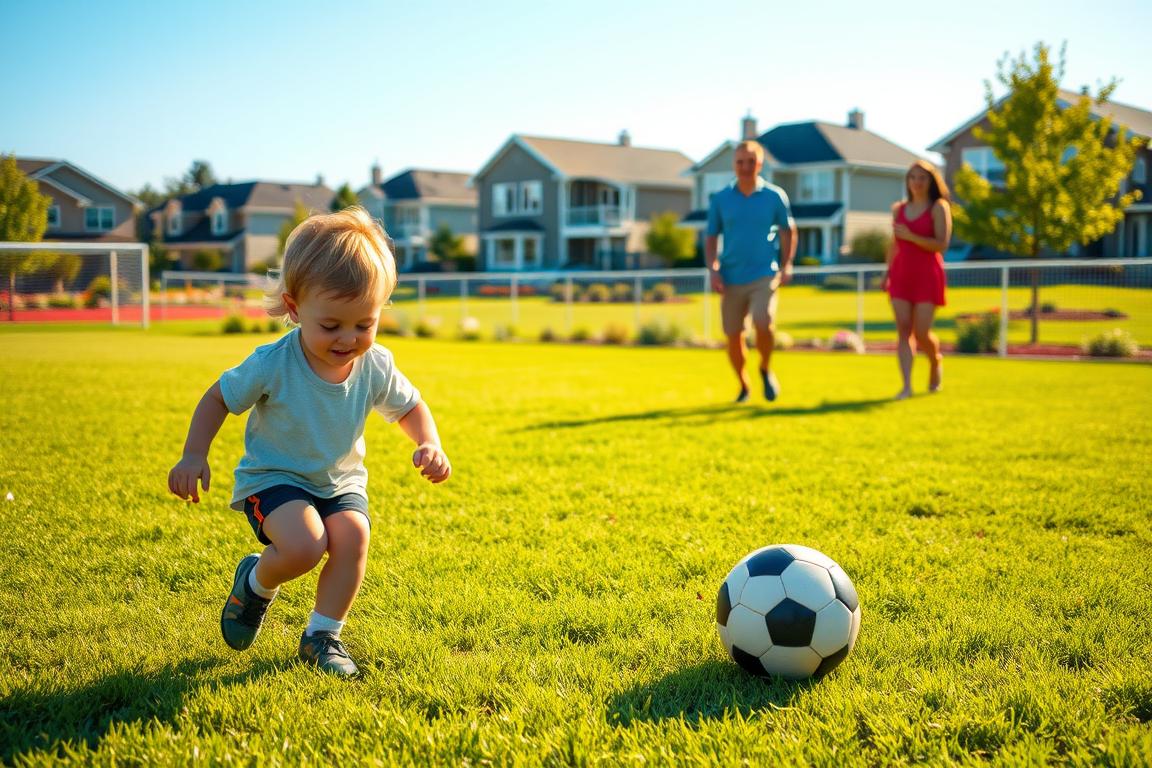How to Encourage Your Child in Soccer – A Parent’s Guide

How to encourage your child in soccer can feel tricky when you want progress without pressure.
I write as a parent and mentor who believes small steps win. Ten extra minutes of practice a day makes a real difference. Simple home drills, steady endurance work, and warm praise build skill and confidence over years.
I share clear, short habits you can use with limited time. You will learn what gear matters, which core skills to focus on, and how fun must lead learning. I also point you toward follow-along drills and videos like those at toddler ball control tips for easy practice at home.
Key Takeaways
- Small daily practice beats long, rare sessions.
- Pick basic gear: a proper ball, cleats, and shin guards.
- Focus on dribbling, passing, and shooting first.
- Keep the sideline calm and make sessions fun.
- Build endurance with steady running or swimming.
- Patience and persistence pay off over the years.
Support without pressure so your child enjoys the game
I choose encouragement that builds confidence, not stress. I am a parent who keeps the sideline calm and trusts the coach’s plan.
Use encouragement, not sideline coaching
Cheer effort, not tactics. I avoid shouting instructions. I let the coach coach and save questions for later.

Ask better post-game questions
I ask simple, open prompts like “What was your favorite moment?” or “When did you feel proud?”
I skip quick critiques and let the child start the talk.
Be a role model with active habits
I walk, bike, or run with my kids. Small habits show the role activity plays in fun and health.
Balance sports with school and play
- I keep school, sleep, free play, and activities balanced so pressure stays low.
- I limit screens on practice days and use a live match as a shared moment.
- I praise teamwork and attitude more than scores, and I help child name one small win each game.
Practical ways to help at home and on the field
I keep practice simple and focused. Start with the right gear: a size-appropriate ball, well-fitting cleats, and shin guards for safe time on the field.
- Pick one skill per session. Work on dribbling, passing, or shooting. Count touches to track progress.
- Use short reps. About ten minutes daily builds skill without stress on schedules.
- Mix fun and fitness. Add 1v1s, dribble tag, or gate passing. Throw in a short jog, jump rope, or swim for endurance.
- Rotate locations. Tight dribbling at home, passing at the park, shooting on the field keeps practice fresh.
- Log progress. Have your player write reps in a notebook so development feels visible.
- When structure helps, use follow-along videos like this training resource.
| Item | Why it matters | Quick tip |
|---|---|---|
| Ball (size-appropriate) | Comfortable handling and more quality touches | Choose correct size for age |
| Cleats | Better traction and safer play on grass | Fit snugly, check growth each season |
| Shin guards | Protects legs and boosts confidence on the field | Wear sleeves or tape to keep them in place |
How to encourage your child in soccer through team and coach support
A strong partnership with the coach helps players focus on growth rather than pressure.
Partner with the coach and trust the program
I introduce myself early and ask one quick question about the program plan. I respect roles on game day and save detailed chats for practice or email.
Set clear, realistic goals your child owns
I help my player pick one or two simple goals. For example: “five clean first touches per game” or a target for assists.
Keep goals matched to current levels so progress feels doable. Track small wins and praise effort first.
Use game highlights to learn and celebrate
I record brief clips and review them for one idea at a time, like scanning before a pass. Tools such as PlayerFocus make it easy to capture a player-centered highlight.
We celebrate team moments and use clips to build habits, not pressure.

- Introduce yourself to the coach and share a positive note about development.
- Respect game roles and ask questions at a scheduled time.
- Review highlights weekly and praise what went well first.
| Action | Why it helps | Quick step |
|---|---|---|
| Meet the coach | Builds trust and aligns expectations | Say hello at first practice |
| Set one goal | Keeps focus clear and achievable | Pick a simple, measurable aim |
| Review clips | Spot habits and celebrate effort | Watch one highlight per week |
Match expectations to age, level, and interest
Set goals that fit the child’s age and curiosity. I keep things simple and clear so sport stays fun and steady. Match what you expect with how much energy and focus the player has.
Ages 4-6
Make sessions playful and short. Let kids run, laugh, and touch the ball on the field. Focus on motor skills, social play, and burning energy so sleep and mood improve.
Ages 7-9
Add a bit more structure. Try one small goal each session, like ten inside-foot passes in a row. Keep drills light and praise effort.
Ages 10-12+
Families often center on weekend games and team time. Talk about position, levels, and practice load together. Protect school and rest while asking the player what they want to try.
- Playful first at 4-6: short bursts and smiles.
- Simple goals at 7-9: build core habits.
- Balance at 10-12+: school, rest, and sport fit together.
| Age band | Main aim | Quick step |
|---|---|---|
| 4-6 | Motor skills & play | Short games on the field |
| 7-9 | Basics & habits | One simple goal per session |
| 10-12+ | Commitment & balance | Discuss position and load |
Conclusion
Let me leave you with a short action plan that keeps sport fun.
Pick one simple skill for today — try five minutes of first-touch work using the inside of the foot. Add five more minutes of dribbling in a small space on the field. Ten minutes total each day builds real progress for a young player.
After games, ask a light question like, “What was your favorite moment?” Use short highlights to celebrate effort and show players what they did well. Partner with the coach and share one positive note each month; that small role builds trust.
Protect family time, homework, and sleep so children stay fresh for activities and games. Let the player choose one activity outside soccer they love. I close with this: encourage child with love, keep things simple, and enjoy the ride.
